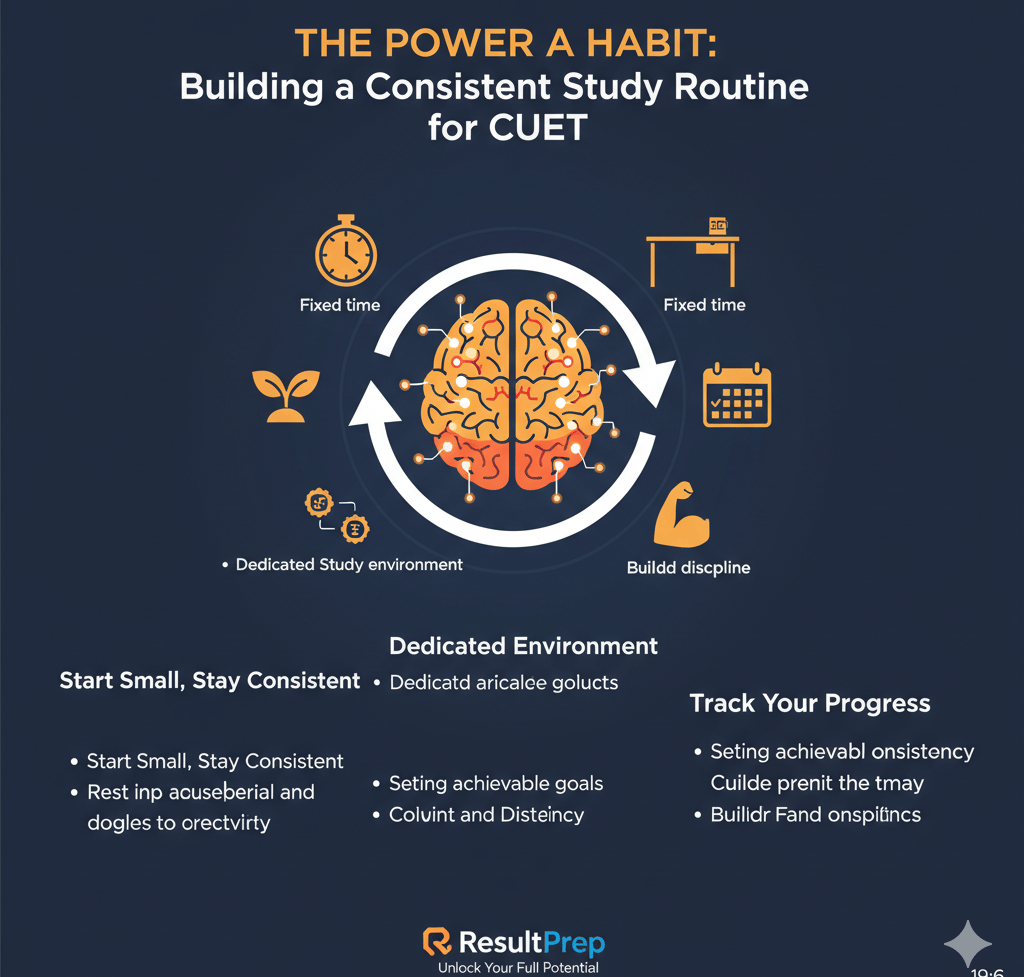🔁 The Power of Habit: How to Build a Winning CUET Study Routine
Consistency beats motivation every time! 💪 Discover how small daily habits, smart time management, and the “cue–routine–reward” formula can transform your CUET preparation into a stress-free, focused journey. Learn ResultPrep’s proven techniques to stay disciplined, motivated, and exam-ready—one study session at a time. 🎯
CUET
10/9/20253 min read


Motivation: The Power of Habit: Building a Consistent Study Routine for CUET
Introduction
Consistency is the secret ingredient to success in any competitive exam, and the CUET (Common University Entrance Test) is no exception. Many students start their preparation with high energy and motivation but struggle to maintain the same focus over time. What separates top performers from the rest is not just intelligence—it’s habit. The power of habit can transform your CUET preparation from a stressful sprint into a smooth, consistent journey.
This blog explores how building strong study habits can help you stay disciplined, motivated, and exam-ready throughout your CUET preparation journey.
Why Habits Matter in CUET Preparation
Motivation can fluctuate, but habits keep you going even on days when you don’t feel like studying. Once studying becomes part of your daily routine, it no longer feels forced—it becomes natural.
Strong study habits:
Help you stay organized and reduce last-minute stress.
Improve focus and time management.
Build discipline and self-confidence.
Ensure consistent progress toward your CUET goals.
Remember, success in CUET isn’t about studying the hardest—it’s about studying consistently and smartly.
Step 1: Start Small, Stay Consistent
One of the biggest mistakes students make is trying to change everything at once. Start small and build gradually. For example:
Begin with two hours of focused study per day.
Once that becomes a habit, slowly increase your study duration.
Set a fixed time every day for studying—your brain learns to associate that time with focus.
Even a small, consistent effort each day compounds into huge progress over months.
Step 2: Create a Dedicated Study Environment
Your environment plays a big role in shaping habits. Choose a quiet, clean space for studying—free from distractions like phones or social media.
Keep all your study materials, water, and stationery handy.
Make your desk inviting—a place where your brain automatically switches into “study mode.”
Avoid studying on your bed, as it can make you sleepy and reduce productivity.
A dedicated environment trains your mind to focus whenever you sit down in that space.
Step 3: Set Clear, Achievable Goals
Goal-setting turns your CUET preparation into a structured journey instead of random study sessions.
Daily goals: Number of topics or chapters to cover.
Weekly goals: Revision or mock test completion.
Monthly goals: Full-length practice papers or subject reviews.
Write your goals down and check them off once completed. This creates a sense of achievement and keeps you motivated.
Step 4: Use the “Cue–Routine–Reward” Technique
According to Charles Duhigg’s The Power of Habit, every habit follows a three-step loop:
Cue: A trigger that reminds you to start (e.g., a specific time, alarm, or song).
Routine: The actual action (e.g., sitting down to study).
Reward: The satisfaction or treat you give yourself afterward (e.g., a short break, snack, or favorite activity).
Example:
Cue: 5 PM alarm rings.
Routine: You study CUET General Test for 90 minutes.
Reward: Watch a 10-minute YouTube video or listen to music.
Over time, your brain connects the cue with the routine and expects the reward—turning studying into a powerful, automatic habit.
Step 5: Use Time Blocks and the Pomodoro Technique
Instead of studying for long, unfocused hours, break your study sessions into time blocks. The Pomodoro Technique is a popular method:
Study for 25 minutes (completely focused).
Take a 5-minute break.
After four sessions, take a longer 15–20-minute break.
This improves concentration, prevents burnout, and makes study sessions more productive.
Step 6: Track Your Progress
Tracking progress helps you stay accountable and visualize your growth. Maintain a study journal or use an app to note what you’ve studied and what’s pending.
You can also:
Color-code topics by confidence level (Green = strong, Yellow = average, Red = needs work).
Review your weekly progress every Sunday.
Reward yourself for consistency—watch a movie, eat your favorite snack, or take a day off.
Small rewards motivate your brain to continue the habit loop.
Step 7: Build Healthy Supporting Habits
Good study habits thrive when supported by other healthy habits:
Sleep well: Aim for 7–8 hours every night.
Eat balanced meals: Proper nutrition boosts focus and energy.
Exercise regularly: Even a 20-minute walk improves alertness.
Stay positive: Replace “I can’t do this” with “I’ll do my best today.”
Consistency isn’t about perfection—it’s about persistence. Some days will be harder, but sticking to your core routine will carry you through.
Conclusion
Building strong study habits for CUET is like training a muscle—the more you practice, the stronger it gets. Motivation might get you started, but habit keeps you going. With small daily steps, structured time management, and a positive mindset, you can transform your preparation into a steady path toward success.
At ResultPrep Coaching, we guide students to develop powerful study routines using structured planning, revision techniques, and motivational strategies that bring consistency and confidence. Remember—success in CUET is built not in a day, but every day.
📞 Call: 8970007497
🌐 Visit: www.resultprep.com
Prepare for the best results!
Achieve your goals with expert coaching and support from ResultPrep.
Contact us:
© 2025. All rights reserved.
Address:
GSS Complex, 2nd Floor,
16th Cross Rd, HMT Layout, Vidyaranyapura, Bengaluru, Karnataka- 560097
